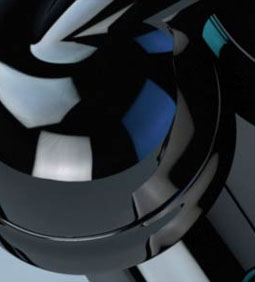


Frequently Asked Questions
What is special about your HDRI files that make the lighting look so real?
They were produced by lighting real objects first. We chose generic object types to cover a variety of lighting situations, then replaced the stand-in object with the Spheron camera to capture the light intensities.
Why have the backgrounds been retouched to solid black on the Neutral and Gel set-ups?
In both these situations the HDRI files were derived from using a blacked out studio. The scans were sensitive enough to capture a lot extraneous details such as leads and the brickwork right into the corners on the room. After testing the files on 3D reflective objects, however, this ambient lighting was found not to contribute to the reflections even after boosting the intensity of the files above 2000%. Removing this redundant data gave a cleaner look when used with Maya and the files compress more efficiently.
The Gels seem to be darker than the Neutral ones. Why is that?
The gels effectively absorb the lights by a stop or two when the lights were at maximum brightness. So, in a real studio environment, to get deep saturated colored lights they would be darker. Since this ends up as an image it is possible to boost the light to suit the situation - just like opening the lens by two stops to compensate.
Can I add or remove a color cast to the Neutral set ups?
Yes, this will depend on how your software handles HDRI files. In Maya, use the Color Gain to add a color cast globally to the set-up. This can be useful if you want to get the lighting temperature warmer or cooler. If you want to remove a color cast use the color picker and select the opposite color on the color wheel.
What are the advantages of using your HDRI environments over just using standard lights?
The lighting available from our maps is based on a live photographic studio scenario where the photographer set up the lighting and balanced the exposures. Photographers approach lighting in a fundamentally different way due to real time feedback of the light interacting with the objects. The photographer's lighting skills are, in a sense, built into the maps as opposed to you having to create a virtual set-up yourself.
What are the advantages of using studio lights?
They have neutral connotations and do not add any cultural cues or any other layer of meaning on top of the image content. So an urban or forest environment, for example, seen in the reflection may add some unintended, and in some cases, incongruous nuance to the image.
Are your files available on CD ROM or DVD?
We may supply on DVD subject to demand. We think that given the tight deadlines most people are working towards, a direct download is preferable.
Are there any tips or tricks to using HDRI-Studio environment maps?
A ReadMe.pdf file is contained within each download zip file that contains workflow advice on how to get the best out of these images.
Why are the Abstract set ups recommended for reflection maps only?
In testing, we found that the Abstract environments work best as environmental reflections and performed less well for illumination. As we are essentially sampling for lights, once the ratio of light to dark drops to a certain point, artifacts start to become apparent and increasing the number of samples will not eliminate them. We are aware that some rendering software vendors are developing their own methods for dealing with these "tiny dot" issues. When the issues are addressed by a number of rendering vendors we will remove this recommendation.
Website design and contents © Copyright 2004-2016 HDRI-Studio Limited. All rights reserved.

